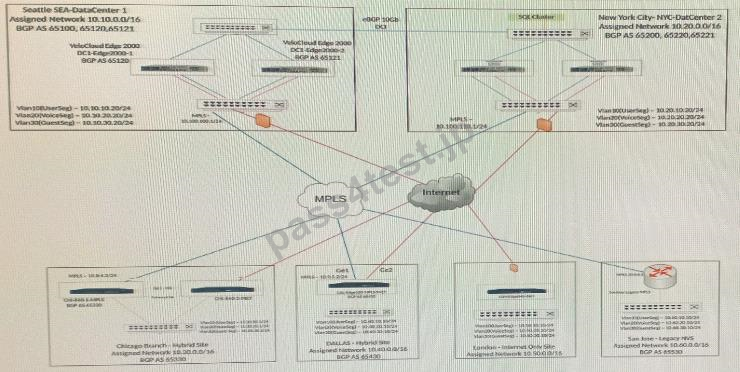Scenario 3:
After resolving numerous connectivity Issues throughout the various branch sites, connectivity between applications and users is finally present. The network administrator is informed that during certain tests, applications are not performing as they are expected to. Users report that call quality has not fully improved and that some of their calls either drop or have poor voice quality where the conversation is breaking up. Other users are noticing that file transfers are slower than expect. A group of users from a few sites have reported slowness in accessing internal and external applications.
Exhibit.

The network administrator has been made aware that Chicago is receiving traffic from non-SD-WAN sites, bottlenecking Chicago's interfaces. The network administrator's VMware SE has mentioned using the uplink feature to help resolve this.
What are two ways the uplink feature should be used in this scenario? (Choose two.)
A. Prevent the site in question from becoming a transit site.
B. Set the uplink community to forward traffic to a group of neighbors.
C. Stop mutual redistribution of routes from underlay and overlay.
D. Direct all traffic to that neighbor designated as an uplink,
正解:A,D
質問 2:
Scenario 3:
After completing the branch activation activities for all required branches, the network administrator attempts to test connectivity between the various branches and between the hubs and branches. The administrator notices a lack of connectivity despite being certain that configurations have been complete. The administrator also observed that several users are reporting intermittent connectivity to some of the applications they are accessing. Other users are reporting no access to these applications. Other users at some of the branches claim they cannot get to certain public resources. The administrator wants to ensure that all sites can talk to each other and all resources are accessible.
Exhibit.

The network administrator determines that dynamic routes to SD-WAN sites are missing at the San Jose branch router. The network administrator decides to look into the configurations of hub Edges. All SD-WAN branch sites must use a hub to communicate with the San Jose site. Best practices have been implemented at these SD-WAN sites.
Where should the administrator check first to verify if the configuration is correct?
A. Verify the static routes to San Jose from all Branches are configured.
B. Verify that the NVS feature is enabled in Cloud VPN.
C. Verify that redistribution at the Dallas Hybrid Site is enabled for San Jose to use as a peering point.
D. Verify that redistribution between the primary hub site and San Jose is enabled.
正解:A
質問 3:
Scenario 2:
After completing the branch activation activities for all required branches, the network administrator attempts to test connectivity between the various branches and between the hubs and branches. The administrator notices a lack of connectivity despite being certain that configurations have been complete. The administrator also observed that several users are reporting intermittent connectivity to some of the applications they are accessing. Other users are reporting no access to these applications. Other users at some of the branches claim they cannot get to certain public resources. The administrator wants to ensure that all sites can talk to each other and all resources are accessible.
Exhibit.

Users at the London site are complaining of various intermittent issues around websites not loading, or applications being remotely accessed disconnecting sporadically and reconnecting after a few minutes. The network administrator does not see anything strange on the Edge overview page and decides to check if the CPU or memory have been hitting close to 100%.
Where should the administrator verify this information?
A. In the VCO > Test 8c Troubleshoot > Remote Diagnostics > System Status
B. In the VCO > Remote Troubleshooting > Remote Actions > System Status
C. In the VCO > Monitor > Click London_Site01 > Click the System Tab
D. In the VCO > Monitor > Alerts
正解:C
質問 4:
Scenario:1
A network administrator is tasked with enabling SD-WAN at three branch locations, A topology has been provided for reference. For each site, the administrator is having issues bringing edges online, as another administrator has gone ahead and created a configuration ahead of time. The organization has several branch sites. One is an Internet-only site and two are Hybrid locations with both internet and MPLS. The last location is MPLS only. There are hub data center in this environment as well. Please refer to the topology.
Exhibit.

One of the Edges at the Chicago site is unable to activate. The Edge has a red LED. What is the next troubleshooting step?
A. If the Edge is connected to its HA peer, determine if underlay BGP peering is present between the two Edges.
B. If the Edge is connected to its HA peer, determine if there is a link-light on the HA peer-link.
C. If the Edge is connected to the MPLS circuit, determine if the Hub is advertising gateway routes.
D. If the Edge is connected to the MPLS circuit which does not have DHCP, determine if there is a static IP configuration that needs to be applied upon activation.
正解:D


 992 お客様のコメント
992 お客様のコメント





Sonobe -
Pass4Testから提供されたこの5V0-41.20問題集一つで習得できました。幸せです。